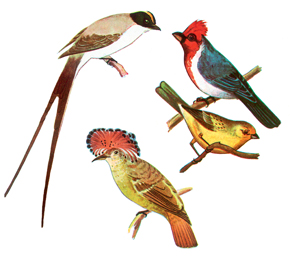
Reproductions from the books Os insetos and Pássaros do Brasil (illustrations by Marian Colonna)Sketch of the body of an insect (grasshopper)Reproductions from the books Os insetos and Pássaros do Brasil (illustrations by Marian Colonna)
Among the travelers, priests and naturalists who wrote about Brazilian nature for a wide audience, it is hard to find anyone so prolific, all-embracing and enthusiastic as Eurico de Oliveira Santos, an agronomist born in Rio de Janeiro in 1883. Between 1910 and the late 1960s, Santos wrote for newspapers, established four journals of agronomy and published some 50 books on animals and plants of Brazil. His work preceded that of José Reis, a better-known science communicator and Rio-born physician who wrote initially about bird diseases in the journal O Biológico, published by the Biology Institute of São Paulo beginning in 1935, and later about science in general in leading São Paulo newspapers, most notably Folha de S.Paulo.
Like José Reis in O Biológico, Eurico Santos took satisfaction in introducing readers to nature, without abandoning precision. With a broader perspective than his successor, Santos wrote texts about domestication of dogs—the subject of the first book in 1927, trees of Brazil, gardens and orchards, diseases of fruits, and the subject that cemented his fame, the lives and habits of Brazilian animals including amphibians and reptiles, fish, mollusks, insects, birds and mammals. These were later compiled and republished by the Itatiaia publishing house. He never failed to receive help and support from specialists who admired the work he did to bring scientific knowledge to a widespread public. For example, Arthur Neiva, director of the Biology Institute, wrote the preface to Pássaros do Brasil [Birds of Brazil], in 1940.

Reproductions from the books Os insetos and Pássaros do Brasil (illustrations by Marian Colonna)Birds of Brazil (clockwise): flycatcher (Muscivora tyrannus), cardinal (Paroaria coronata), Saffron Finch (Sicalis flaveola flava) and Amazonian Royal Flycatcher (Onychorhynchus c. coronatus).Reproductions from the books Os insetos and Pássaros do Brasil (illustrations by Marian Colonna)
Santos turned to writing in simple language because of his interactions with journalists while studying agronomy, and because of the scarcity of books about Brazilian animals, whereas there were many about animals in other countries. His role as a science communicator was to bring specialized knowledge to the general public, in a comprehensive manner. “A person who communicates to disseminate science among non-specialists does not need to be profound, and that very lack of depth even becomes an essential quality for the communicator. What he needs first and foremost is to be light, concise, pleasant,” he reasoned in the preface to Moluscos [Mollusks].
“His writing was captivating,” comments Fernando Costa Straube, an ornithologist from Pará State who admires Santos’ work. “Children who had recently learned to read began to develop a taste for research, thanks to his books, which were produced in clear, accessible language.” Straube himself had already read Da ema ao beija-flor [From emus to hummingbirds] when, at the age of 15, he got another book by Eurico Santos, Pássaros do Brasil [Birds of Brazil], from his first high-school biology teacher, Zélia Arns. Arns was his cousin and the sister of Cardinal Paulo Evaristo Arns and Zilda Arns, the pediatrician and humanitarian.

Reproductions from the books Os insetos and Pássaros do Brasil (illustrations by Marian Colonna)A queen ant laying eggsReproductions from the books Os insetos and Pássaros do Brasil (illustrations by Marian Colonna)
Eurico Santos wrote actively for newspapers over the course of decades. In one Rio newspaper, O Jornal, in 1930 he created—and maintained for more than 30 years—the Life in the Country section, according to former University of São Paulo (USP) Professor Hitoshi Nomura, a scholar of his work. In the 1950s, according to Nomura, “practically every Brazilian newspaper printed his articles,” which were distributed by the Ministry of Agriculture’s Agricultural Information Service.
“He was short in stature, an excellent prose writer and a demanding gourmet. Exchanging ideas with him was a satisfying experience,” Nomura said in 2009 in reference to his meeting with Santos in 1959. Having been recognized by several scientific societies and having received an award from President Juscelino Kubitschek, Eurico Santos died in 1968. His style of writing easy-going texts that anyone can understand cannot be forgotten, Straube points out. “Authors of the past give us excellent paths that can and should be followed.”
Republish